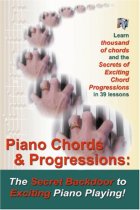Add Chord Fillers To Your Piano Songs Using “Echo Chords” (A Podcast – No Video)
Echo Chords – What They Are & How To Use Them
| Hello, this is Duane with more good stuff you really ought to know. Today I’d like to look at the easiest kind of fill that there is – echo chords. When people start arranging, they think about runs, and fills, and counter-melodies, and so on, and so forth, but the easiest possible thing is to put in an echo chord. What does that mean? It simply means what it says. You just echo the chord. If your chord was this, then you echo it.
|
| You and I know what an echo is. If you yell down the Grand Canyon, “Hello, down there!” The echo comes back softer than the shout itself, right? Unless it was magnified, but in normal context, they echos come back softer so that’s what you should do too. When you echo something, make it softer than the thing you’re echoing. Don’t go like this. Not unless you want a different kind of effect, but that’s not really an echo. An echo is what it says it is. You’re echoing what was just played.
|
| There’s so many opportunities in music to echo, because there’s so many notes that get more than one beat. Any time you have a note that gets more than one beat, one, two, three, you see that? I had three beats there, so the chord was C major seventh, and I just echos it an octave higher, and an octave higher than that. I went straight up. You can do those echos in a variety of ways. You could roll them from the bottom up, or from the top down, inside out, there’s just lots of ways to do it. That’s the simplest way to get started in fills. Just chordal echos.
|
| You should know also that there are lots of ways you can use echos. You’re not limited to that. In addition to chord echos, there’s also melody echos. In other words, in that song I was just playing, here’s a melodic echo. You see? I didn’t echo the chord, did I? I didn’t go … But I echoed the melody.
|
| echos … This is not the subject of this little good stuff card, but echos don’t have to be exact, either. They can be approximations. In other words, in a melodic echo, I wouldn’t have to play the exact three notes in the melody itself. I could take two of those three, for example. You see that? I took part of it and echoed. I could take the shape of the melody, but not the exact notes. Listen. See that? I took the shape of the melody, which was down, down, down, and played it on different notes. It’s still an echo, but it’s an inexact melodic echo.
|
| There are also rhythmic echos too. For example, if a melody, or if a tune goes … and you have time, in the next measure, you can come down, and go … You kind of find that question and answer kind of thing in a variety of songs, but particularly in gospel kind of things. It’s like the preacher’s preaching and the congregation is responding. That’s called a rhythmic echo. The echo is an echo of the rhythm, not so much of the melody, or the harmony. Although, you could do all of those. Those could be combined, too.
|
| Well, that’s just more good stuff you really ought to know to be a good musician. We’ll see you next time around.
Click on this link to watch this video on YouTube: https://www.youtube.com/watch?v=ZtNoa2ck-EM&feature=youtu.be ***For lots more good stuff on piano playing come on over to my website at https://www.playpiano.com and sign up for our free piano tips – “Exciting Piano Chords & Sizzling Chord Progressions!” Here’s a great little book on chords and chord progressions on Amazon: http://www.amazon.com/Piano-Chords-Chord-Progressions-Exciting-ebook/dp/B0076OUGDE/ref=sr_1_1?s=books&ie=UTF8&qid=1404158669&sr=1-1&keywords=piano+chords+duane+shinn
|




